Analyzing Economic Concepts: Assignment on Supply, Demand, and Trade
VerifiedAdded on 2022/12/29
|7
|1770
|37
Homework Assignment
AI Summary
This economics assignment delves into fundamental economic principles. It begins by defining and differentiating between macroeconomics and microeconomics, followed by an explanation of absolute and comparative advantage. The assignment then explores the impact of international trade and globalization on emerging economies. Further, it examines open market operations and government measures to control the money supply. The core of the assignment analyzes changes in supply and quantity supplied, and changes in demand and quantity demanded, including the factors influencing them. Finally, it addresses income and cross elasticity of demand with relevant examples. The assignment provides a comprehensive overview of key economic concepts, supported by references to academic literature.
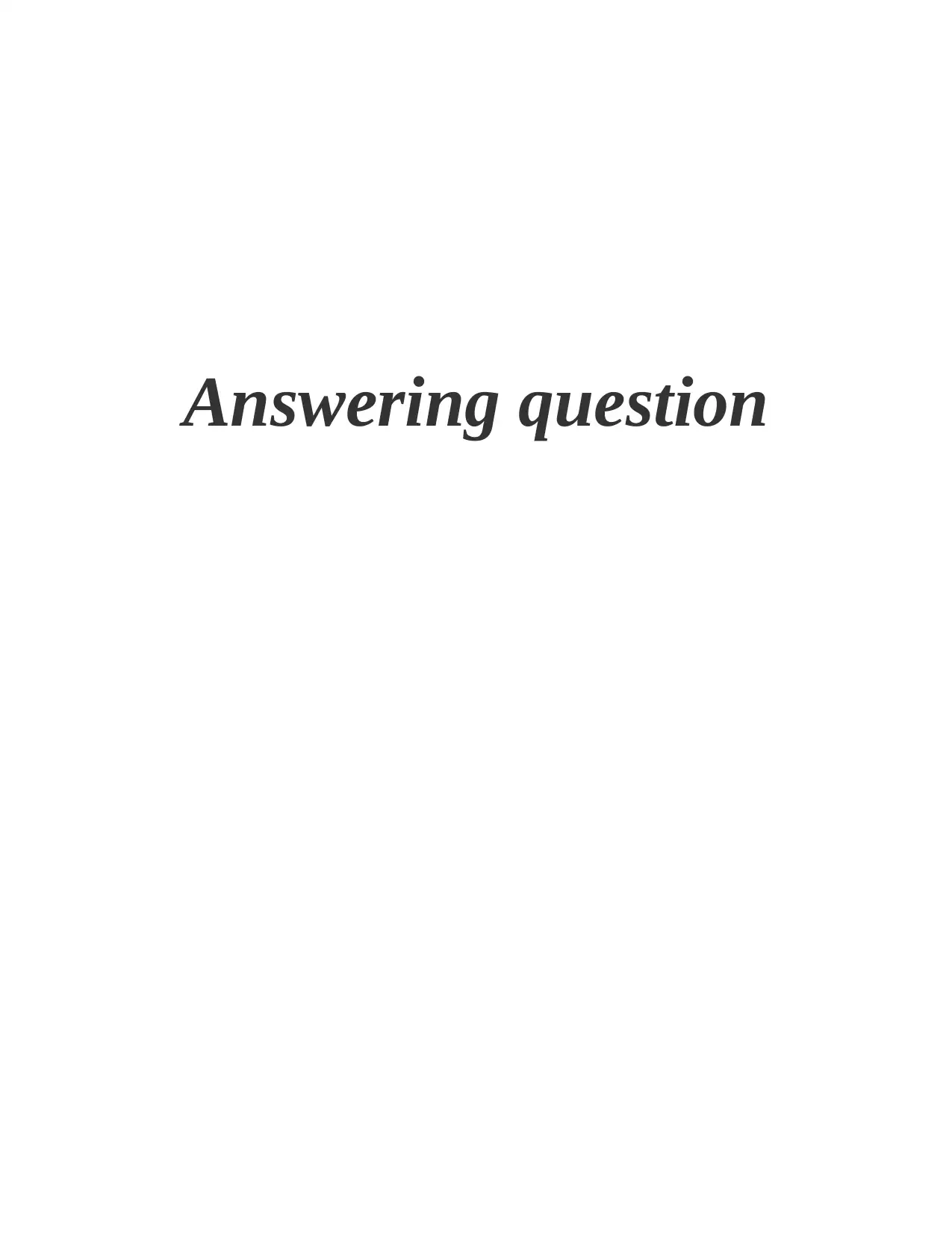
Answering question
Paraphrase This Document
Need a fresh take? Get an instant paraphrase of this document with our AI Paraphraser
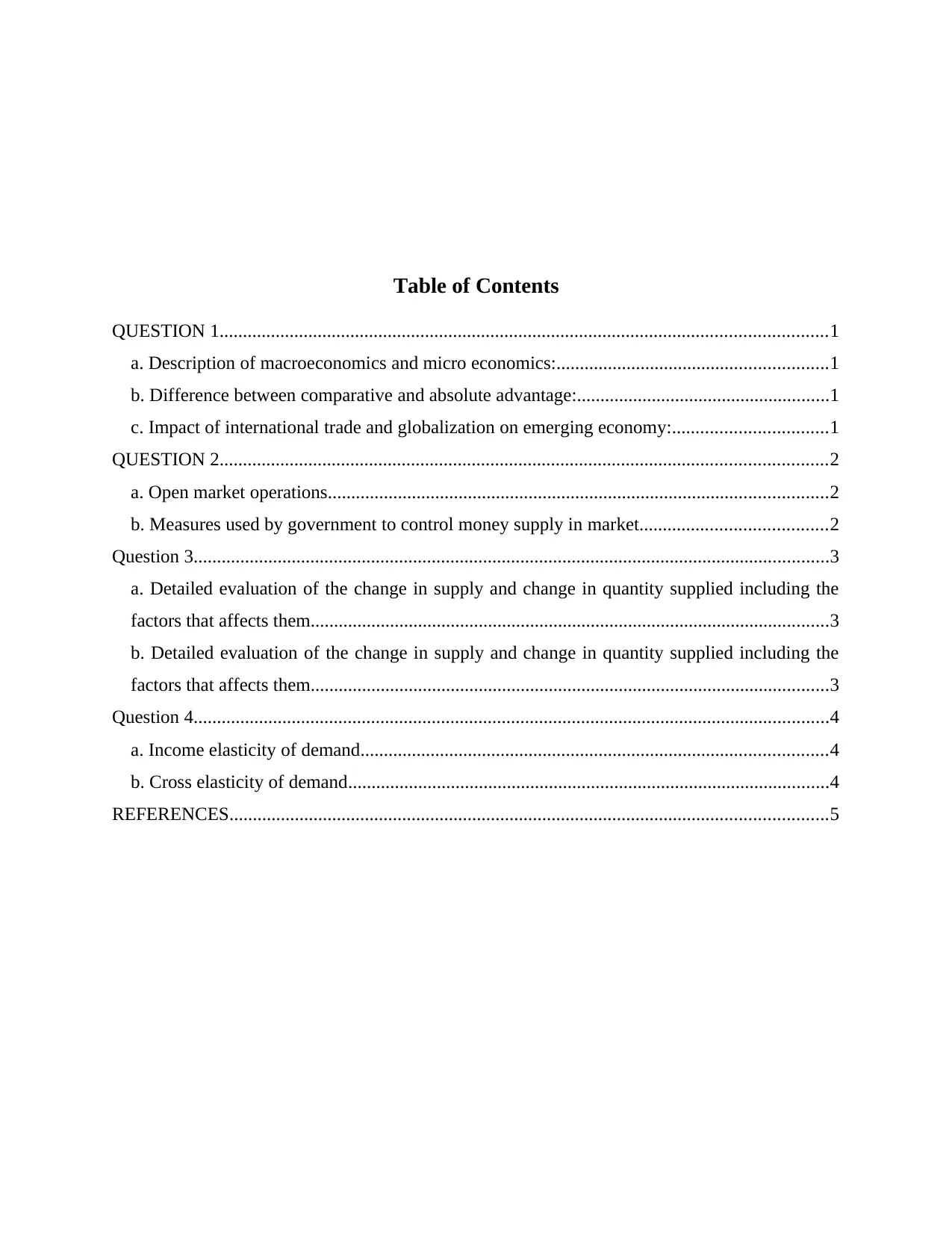
Table of Contents
QUESTION 1..................................................................................................................................1
a. Description of macroeconomics and micro economics:..........................................................1
b. Difference between comparative and absolute advantage:......................................................1
c. Impact of international trade and globalization on emerging economy:.................................1
QUESTION 2..................................................................................................................................2
a. Open market operations...........................................................................................................2
b. Measures used by government to control money supply in market........................................2
Question 3........................................................................................................................................3
a. Detailed evaluation of the change in supply and change in quantity supplied including the
factors that affects them...............................................................................................................3
b. Detailed evaluation of the change in supply and change in quantity supplied including the
factors that affects them...............................................................................................................3
Question 4........................................................................................................................................4
a. Income elasticity of demand....................................................................................................4
b. Cross elasticity of demand.......................................................................................................4
REFERENCES................................................................................................................................5
QUESTION 1..................................................................................................................................1
a. Description of macroeconomics and micro economics:..........................................................1
b. Difference between comparative and absolute advantage:......................................................1
c. Impact of international trade and globalization on emerging economy:.................................1
QUESTION 2..................................................................................................................................2
a. Open market operations...........................................................................................................2
b. Measures used by government to control money supply in market........................................2
Question 3........................................................................................................................................3
a. Detailed evaluation of the change in supply and change in quantity supplied including the
factors that affects them...............................................................................................................3
b. Detailed evaluation of the change in supply and change in quantity supplied including the
factors that affects them...............................................................................................................3
Question 4........................................................................................................................................4
a. Income elasticity of demand....................................................................................................4
b. Cross elasticity of demand.......................................................................................................4
REFERENCES................................................................................................................................5
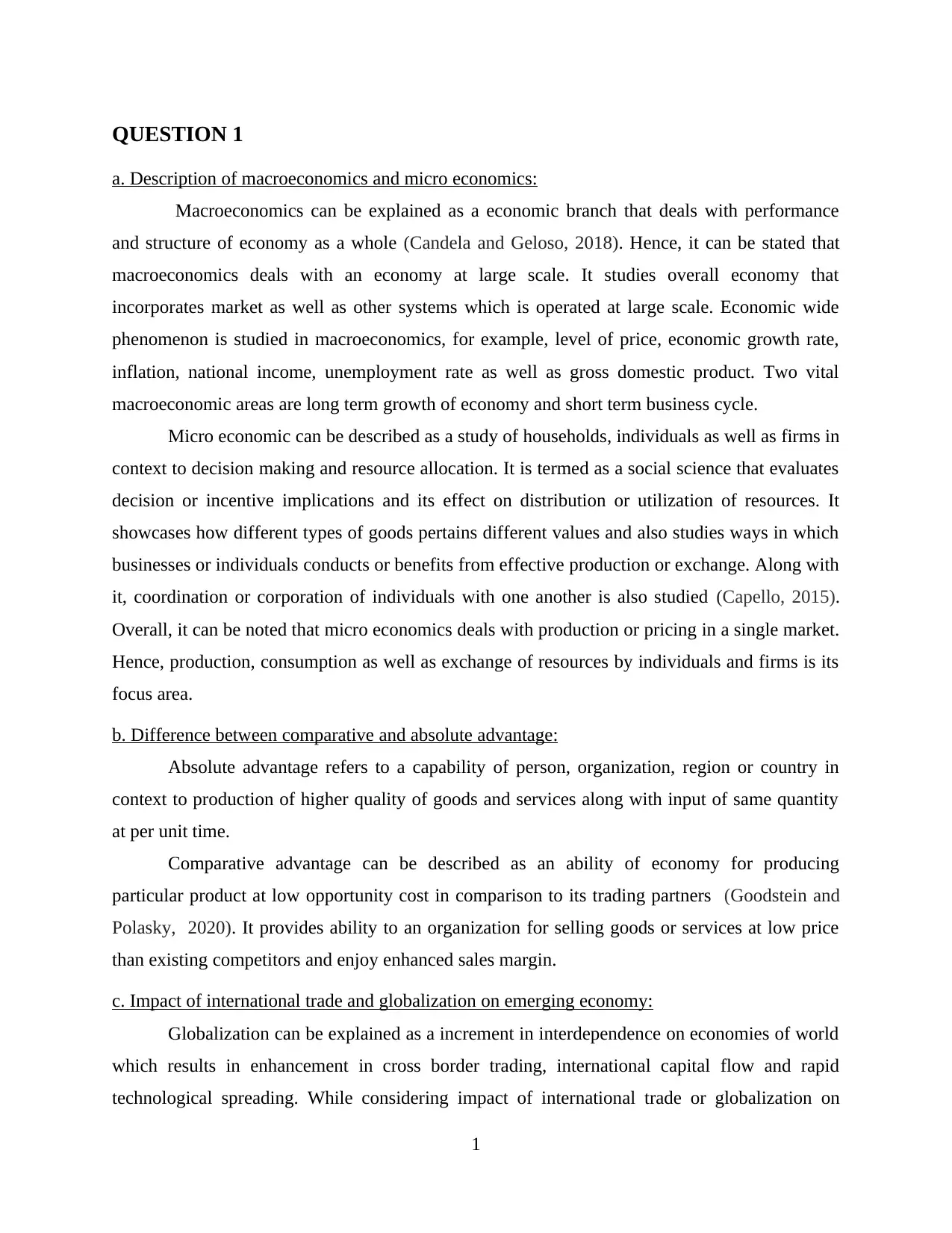
QUESTION 1
a. Description of macroeconomics and micro economics:
Macroeconomics can be explained as a economic branch that deals with performance
and structure of economy as a whole (Candela and Geloso, 2018). Hence, it can be stated that
macroeconomics deals with an economy at large scale. It studies overall economy that
incorporates market as well as other systems which is operated at large scale. Economic wide
phenomenon is studied in macroeconomics, for example, level of price, economic growth rate,
inflation, national income, unemployment rate as well as gross domestic product. Two vital
macroeconomic areas are long term growth of economy and short term business cycle.
Micro economic can be described as a study of households, individuals as well as firms in
context to decision making and resource allocation. It is termed as a social science that evaluates
decision or incentive implications and its effect on distribution or utilization of resources. It
showcases how different types of goods pertains different values and also studies ways in which
businesses or individuals conducts or benefits from effective production or exchange. Along with
it, coordination or corporation of individuals with one another is also studied (Capello, 2015).
Overall, it can be noted that micro economics deals with production or pricing in a single market.
Hence, production, consumption as well as exchange of resources by individuals and firms is its
focus area.
b. Difference between comparative and absolute advantage:
Absolute advantage refers to a capability of person, organization, region or country in
context to production of higher quality of goods and services along with input of same quantity
at per unit time.
Comparative advantage can be described as an ability of economy for producing
particular product at low opportunity cost in comparison to its trading partners (Goodstein and
Polasky, 2020). It provides ability to an organization for selling goods or services at low price
than existing competitors and enjoy enhanced sales margin.
c. Impact of international trade and globalization on emerging economy:
Globalization can be explained as a increment in interdependence on economies of world
which results in enhancement in cross border trading, international capital flow and rapid
technological spreading. While considering impact of international trade or globalization on
1
a. Description of macroeconomics and micro economics:
Macroeconomics can be explained as a economic branch that deals with performance
and structure of economy as a whole (Candela and Geloso, 2018). Hence, it can be stated that
macroeconomics deals with an economy at large scale. It studies overall economy that
incorporates market as well as other systems which is operated at large scale. Economic wide
phenomenon is studied in macroeconomics, for example, level of price, economic growth rate,
inflation, national income, unemployment rate as well as gross domestic product. Two vital
macroeconomic areas are long term growth of economy and short term business cycle.
Micro economic can be described as a study of households, individuals as well as firms in
context to decision making and resource allocation. It is termed as a social science that evaluates
decision or incentive implications and its effect on distribution or utilization of resources. It
showcases how different types of goods pertains different values and also studies ways in which
businesses or individuals conducts or benefits from effective production or exchange. Along with
it, coordination or corporation of individuals with one another is also studied (Capello, 2015).
Overall, it can be noted that micro economics deals with production or pricing in a single market.
Hence, production, consumption as well as exchange of resources by individuals and firms is its
focus area.
b. Difference between comparative and absolute advantage:
Absolute advantage refers to a capability of person, organization, region or country in
context to production of higher quality of goods and services along with input of same quantity
at per unit time.
Comparative advantage can be described as an ability of economy for producing
particular product at low opportunity cost in comparison to its trading partners (Goodstein and
Polasky, 2020). It provides ability to an organization for selling goods or services at low price
than existing competitors and enjoy enhanced sales margin.
c. Impact of international trade and globalization on emerging economy:
Globalization can be explained as a increment in interdependence on economies of world
which results in enhancement in cross border trading, international capital flow and rapid
technological spreading. While considering impact of international trade or globalization on
1
⊘ This is a preview!⊘
Do you want full access?
Subscribe today to unlock all pages.

Trusted by 1+ million students worldwide
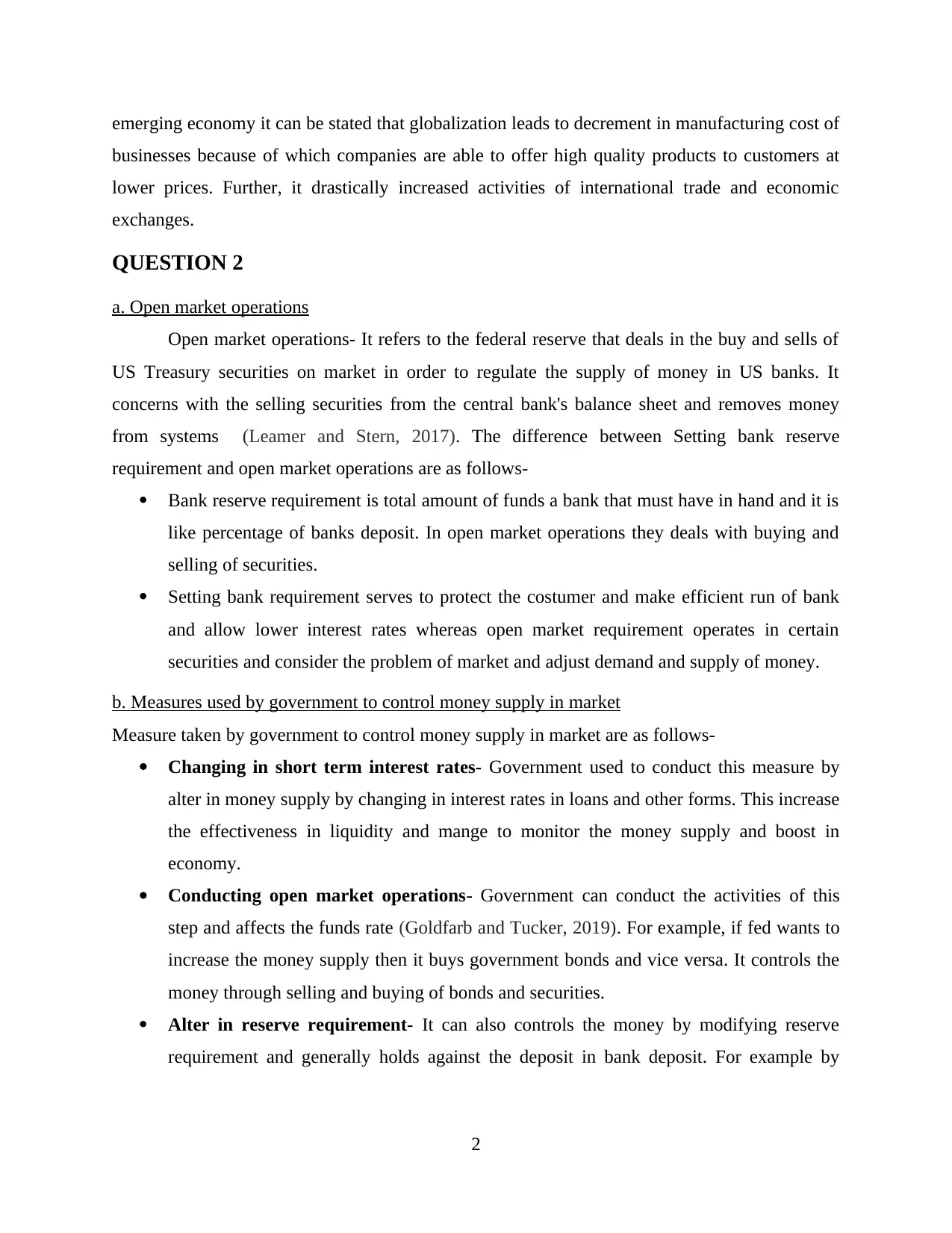
emerging economy it can be stated that globalization leads to decrement in manufacturing cost of
businesses because of which companies are able to offer high quality products to customers at
lower prices. Further, it drastically increased activities of international trade and economic
exchanges.
QUESTION 2
a. Open market operations
Open market operations- It refers to the federal reserve that deals in the buy and sells of
US Treasury securities on market in order to regulate the supply of money in US banks. It
concerns with the selling securities from the central bank's balance sheet and removes money
from systems (Leamer and Stern, 2017). The difference between Setting bank reserve
requirement and open market operations are as follows-
Bank reserve requirement is total amount of funds a bank that must have in hand and it is
like percentage of banks deposit. In open market operations they deals with buying and
selling of securities.
Setting bank requirement serves to protect the costumer and make efficient run of bank
and allow lower interest rates whereas open market requirement operates in certain
securities and consider the problem of market and adjust demand and supply of money.
b. Measures used by government to control money supply in market
Measure taken by government to control money supply in market are as follows-
Changing in short term interest rates- Government used to conduct this measure by
alter in money supply by changing in interest rates in loans and other forms. This increase
the effectiveness in liquidity and mange to monitor the money supply and boost in
economy.
Conducting open market operations- Government can conduct the activities of this
step and affects the funds rate (Goldfarb and Tucker, 2019). For example, if fed wants to
increase the money supply then it buys government bonds and vice versa. It controls the
money through selling and buying of bonds and securities.
Alter in reserve requirement- It can also controls the money by modifying reserve
requirement and generally holds against the deposit in bank deposit. For example by
2
businesses because of which companies are able to offer high quality products to customers at
lower prices. Further, it drastically increased activities of international trade and economic
exchanges.
QUESTION 2
a. Open market operations
Open market operations- It refers to the federal reserve that deals in the buy and sells of
US Treasury securities on market in order to regulate the supply of money in US banks. It
concerns with the selling securities from the central bank's balance sheet and removes money
from systems (Leamer and Stern, 2017). The difference between Setting bank reserve
requirement and open market operations are as follows-
Bank reserve requirement is total amount of funds a bank that must have in hand and it is
like percentage of banks deposit. In open market operations they deals with buying and
selling of securities.
Setting bank requirement serves to protect the costumer and make efficient run of bank
and allow lower interest rates whereas open market requirement operates in certain
securities and consider the problem of market and adjust demand and supply of money.
b. Measures used by government to control money supply in market
Measure taken by government to control money supply in market are as follows-
Changing in short term interest rates- Government used to conduct this measure by
alter in money supply by changing in interest rates in loans and other forms. This increase
the effectiveness in liquidity and mange to monitor the money supply and boost in
economy.
Conducting open market operations- Government can conduct the activities of this
step and affects the funds rate (Goldfarb and Tucker, 2019). For example, if fed wants to
increase the money supply then it buys government bonds and vice versa. It controls the
money through selling and buying of bonds and securities.
Alter in reserve requirement- It can also controls the money by modifying reserve
requirement and generally holds against the deposit in bank deposit. For example by
2
Paraphrase This Document
Need a fresh take? Get an instant paraphrase of this document with our AI Paraphraser
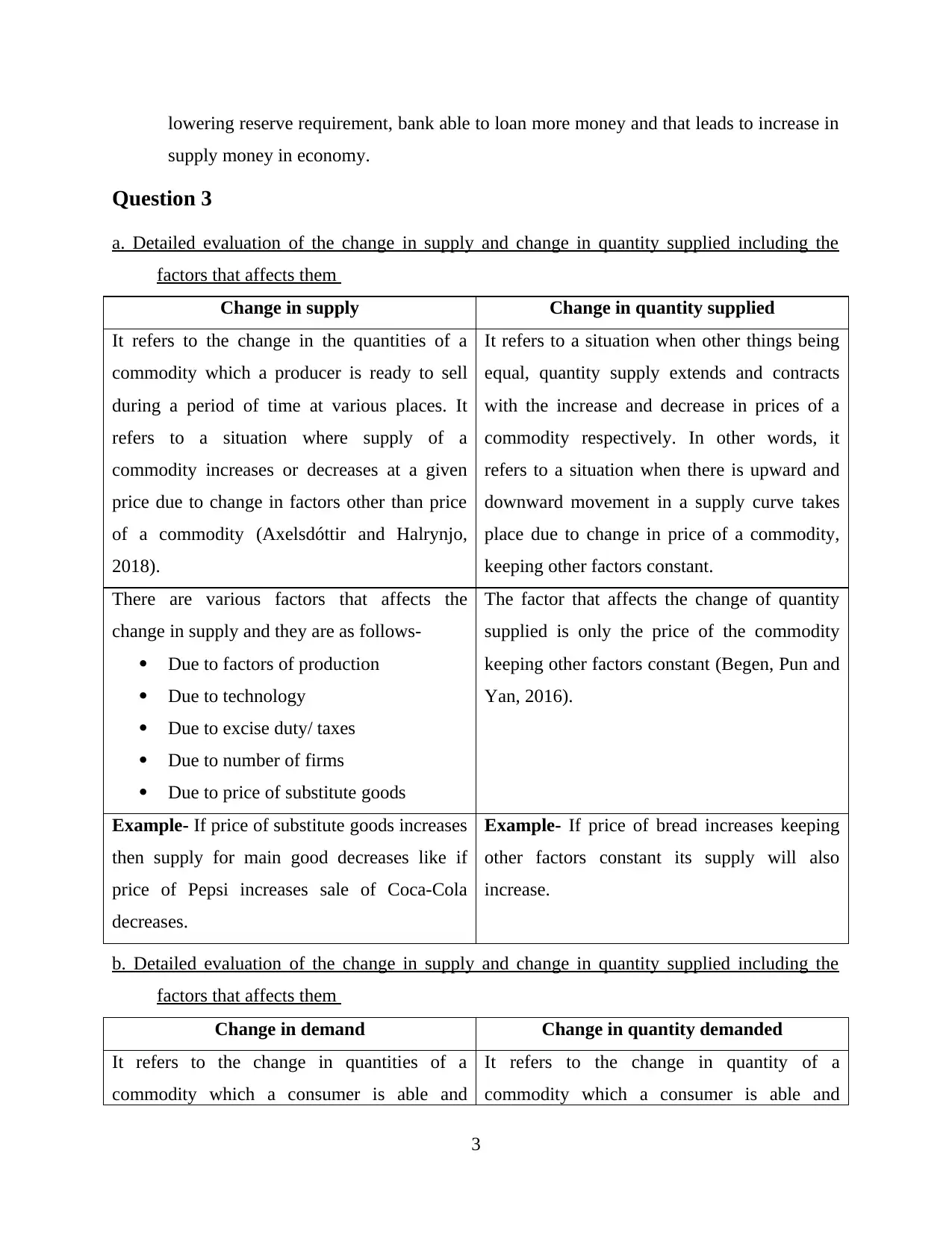
lowering reserve requirement, bank able to loan more money and that leads to increase in
supply money in economy.
Question 3
a. Detailed evaluation of the change in supply and change in quantity supplied including the
factors that affects them
Change in supply Change in quantity supplied
It refers to the change in the quantities of a
commodity which a producer is ready to sell
during a period of time at various places. It
refers to a situation where supply of a
commodity increases or decreases at a given
price due to change in factors other than price
of a commodity (Axelsdóttir and Halrynjo,
2018).
It refers to a situation when other things being
equal, quantity supply extends and contracts
with the increase and decrease in prices of a
commodity respectively. In other words, it
refers to a situation when there is upward and
downward movement in a supply curve takes
place due to change in price of a commodity,
keeping other factors constant.
There are various factors that affects the
change in supply and they are as follows-
Due to factors of production
Due to technology
Due to excise duty/ taxes
Due to number of firms
Due to price of substitute goods
The factor that affects the change of quantity
supplied is only the price of the commodity
keeping other factors constant (Begen, Pun and
Yan, 2016).
Example- If price of substitute goods increases
then supply for main good decreases like if
price of Pepsi increases sale of Coca-Cola
decreases.
Example- If price of bread increases keeping
other factors constant its supply will also
increase.
b. Detailed evaluation of the change in supply and change in quantity supplied including the
factors that affects them
Change in demand Change in quantity demanded
It refers to the change in quantities of a
commodity which a consumer is able and
It refers to the change in quantity of a
commodity which a consumer is able and
3
supply money in economy.
Question 3
a. Detailed evaluation of the change in supply and change in quantity supplied including the
factors that affects them
Change in supply Change in quantity supplied
It refers to the change in the quantities of a
commodity which a producer is ready to sell
during a period of time at various places. It
refers to a situation where supply of a
commodity increases or decreases at a given
price due to change in factors other than price
of a commodity (Axelsdóttir and Halrynjo,
2018).
It refers to a situation when other things being
equal, quantity supply extends and contracts
with the increase and decrease in prices of a
commodity respectively. In other words, it
refers to a situation when there is upward and
downward movement in a supply curve takes
place due to change in price of a commodity,
keeping other factors constant.
There are various factors that affects the
change in supply and they are as follows-
Due to factors of production
Due to technology
Due to excise duty/ taxes
Due to number of firms
Due to price of substitute goods
The factor that affects the change of quantity
supplied is only the price of the commodity
keeping other factors constant (Begen, Pun and
Yan, 2016).
Example- If price of substitute goods increases
then supply for main good decreases like if
price of Pepsi increases sale of Coca-Cola
decreases.
Example- If price of bread increases keeping
other factors constant its supply will also
increase.
b. Detailed evaluation of the change in supply and change in quantity supplied including the
factors that affects them
Change in demand Change in quantity demanded
It refers to the change in quantities of a
commodity which a consumer is able and
It refers to the change in quantity of a
commodity which a consumer is able and
3
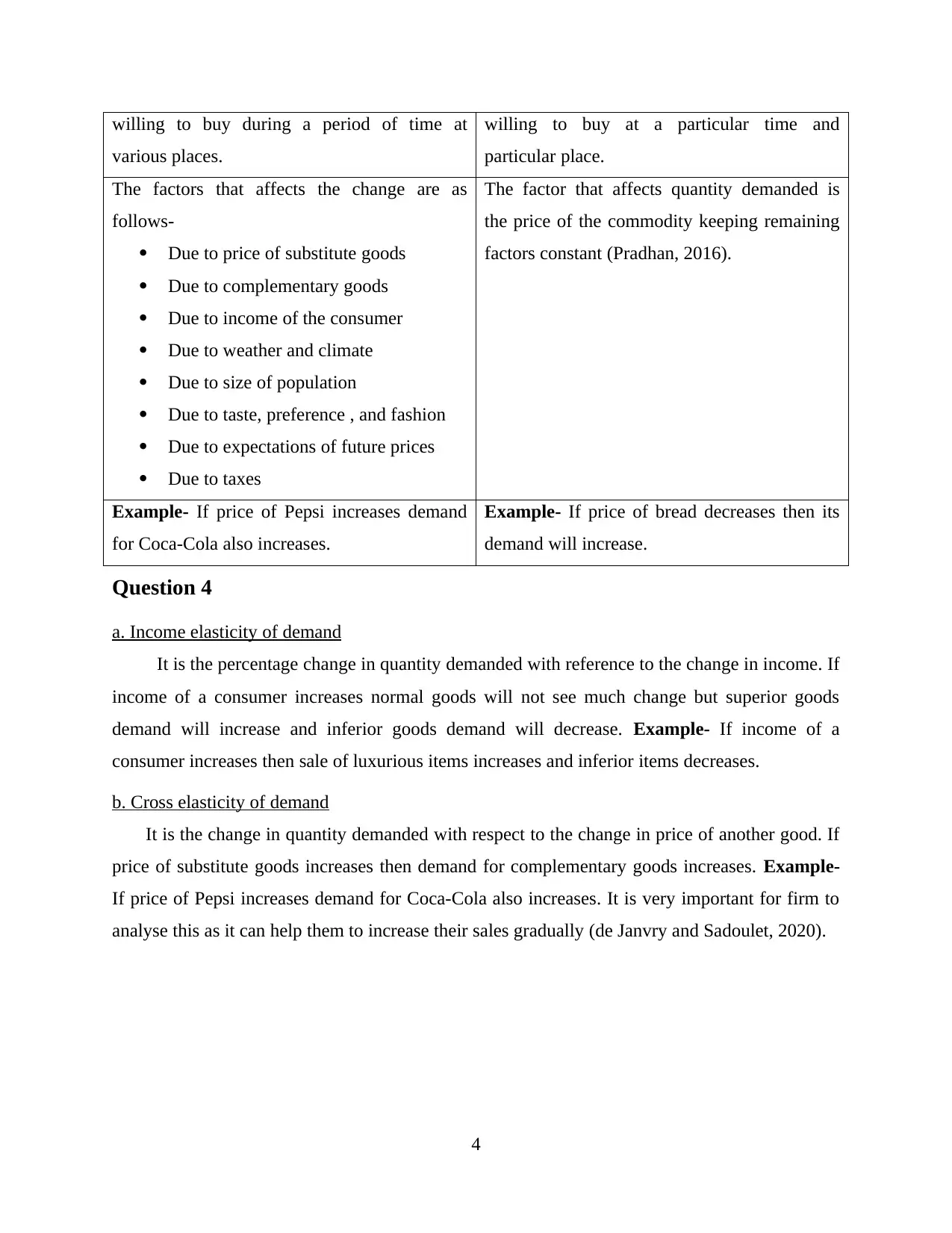
willing to buy during a period of time at
various places.
willing to buy at a particular time and
particular place.
The factors that affects the change are as
follows-
Due to price of substitute goods
Due to complementary goods
Due to income of the consumer
Due to weather and climate
Due to size of population
Due to taste, preference , and fashion
Due to expectations of future prices
Due to taxes
The factor that affects quantity demanded is
the price of the commodity keeping remaining
factors constant (Pradhan, 2016).
Example- If price of Pepsi increases demand
for Coca-Cola also increases.
Example- If price of bread decreases then its
demand will increase.
Question 4
a. Income elasticity of demand
It is the percentage change in quantity demanded with reference to the change in income. If
income of a consumer increases normal goods will not see much change but superior goods
demand will increase and inferior goods demand will decrease. Example- If income of a
consumer increases then sale of luxurious items increases and inferior items decreases.
b. Cross elasticity of demand
It is the change in quantity demanded with respect to the change in price of another good. If
price of substitute goods increases then demand for complementary goods increases. Example-
If price of Pepsi increases demand for Coca-Cola also increases. It is very important for firm to
analyse this as it can help them to increase their sales gradually (de Janvry and Sadoulet, 2020).
4
various places.
willing to buy at a particular time and
particular place.
The factors that affects the change are as
follows-
Due to price of substitute goods
Due to complementary goods
Due to income of the consumer
Due to weather and climate
Due to size of population
Due to taste, preference , and fashion
Due to expectations of future prices
Due to taxes
The factor that affects quantity demanded is
the price of the commodity keeping remaining
factors constant (Pradhan, 2016).
Example- If price of Pepsi increases demand
for Coca-Cola also increases.
Example- If price of bread decreases then its
demand will increase.
Question 4
a. Income elasticity of demand
It is the percentage change in quantity demanded with reference to the change in income. If
income of a consumer increases normal goods will not see much change but superior goods
demand will increase and inferior goods demand will decrease. Example- If income of a
consumer increases then sale of luxurious items increases and inferior items decreases.
b. Cross elasticity of demand
It is the change in quantity demanded with respect to the change in price of another good. If
price of substitute goods increases then demand for complementary goods increases. Example-
If price of Pepsi increases demand for Coca-Cola also increases. It is very important for firm to
analyse this as it can help them to increase their sales gradually (de Janvry and Sadoulet, 2020).
4
⊘ This is a preview!⊘
Do you want full access?
Subscribe today to unlock all pages.

Trusted by 1+ million students worldwide
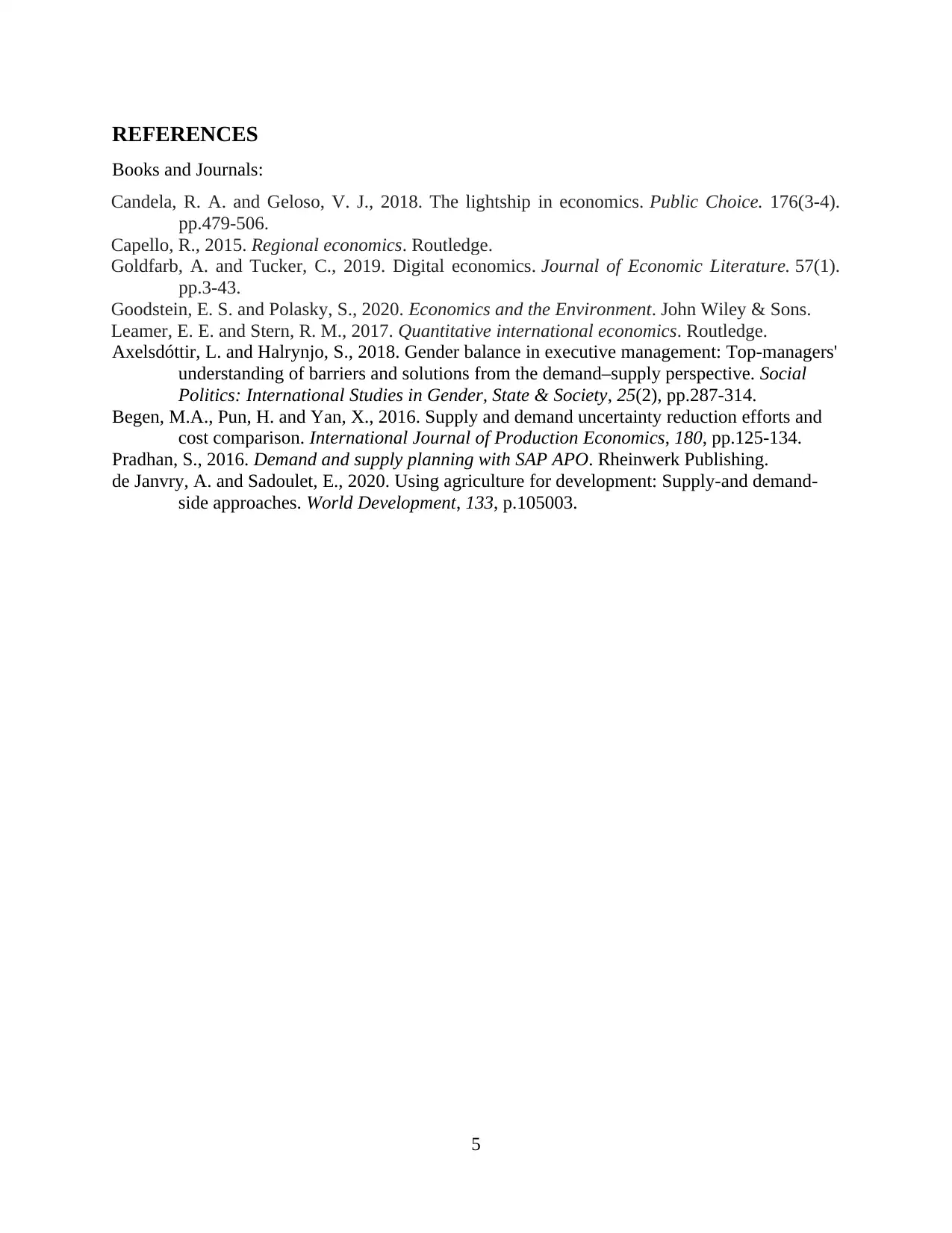
REFERENCES
Books and Journals:
Candela, R. A. and Geloso, V. J., 2018. The lightship in economics. Public Choice. 176(3-4).
pp.479-506.
Capello, R., 2015. Regional economics. Routledge.
Goldfarb, A. and Tucker, C., 2019. Digital economics. Journal of Economic Literature. 57(1).
pp.3-43.
Goodstein, E. S. and Polasky, S., 2020. Economics and the Environment. John Wiley & Sons.
Leamer, E. E. and Stern, R. M., 2017. Quantitative international economics. Routledge.
Axelsdóttir, L. and Halrynjo, S., 2018. Gender balance in executive management: Top-managers'
understanding of barriers and solutions from the demand–supply perspective. Social
Politics: International Studies in Gender, State & Society, 25(2), pp.287-314.
Begen, M.A., Pun, H. and Yan, X., 2016. Supply and demand uncertainty reduction efforts and
cost comparison. International Journal of Production Economics, 180, pp.125-134.
Pradhan, S., 2016. Demand and supply planning with SAP APO. Rheinwerk Publishing.
de Janvry, A. and Sadoulet, E., 2020. Using agriculture for development: Supply-and demand-
side approaches. World Development, 133, p.105003.
5
Books and Journals:
Candela, R. A. and Geloso, V. J., 2018. The lightship in economics. Public Choice. 176(3-4).
pp.479-506.
Capello, R., 2015. Regional economics. Routledge.
Goldfarb, A. and Tucker, C., 2019. Digital economics. Journal of Economic Literature. 57(1).
pp.3-43.
Goodstein, E. S. and Polasky, S., 2020. Economics and the Environment. John Wiley & Sons.
Leamer, E. E. and Stern, R. M., 2017. Quantitative international economics. Routledge.
Axelsdóttir, L. and Halrynjo, S., 2018. Gender balance in executive management: Top-managers'
understanding of barriers and solutions from the demand–supply perspective. Social
Politics: International Studies in Gender, State & Society, 25(2), pp.287-314.
Begen, M.A., Pun, H. and Yan, X., 2016. Supply and demand uncertainty reduction efforts and
cost comparison. International Journal of Production Economics, 180, pp.125-134.
Pradhan, S., 2016. Demand and supply planning with SAP APO. Rheinwerk Publishing.
de Janvry, A. and Sadoulet, E., 2020. Using agriculture for development: Supply-and demand-
side approaches. World Development, 133, p.105003.
5
1 out of 7
Related Documents
Your All-in-One AI-Powered Toolkit for Academic Success.
+13062052269
info@desklib.com
Available 24*7 on WhatsApp / Email
![[object Object]](/_next/static/media/star-bottom.7253800d.svg)
Unlock your academic potential
Copyright © 2020–2025 A2Z Services. All Rights Reserved. Developed and managed by ZUCOL.





